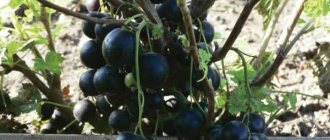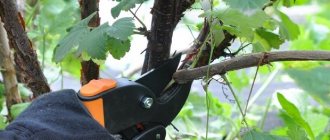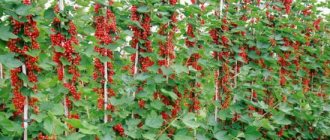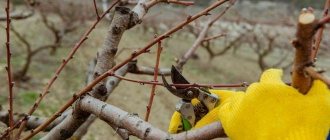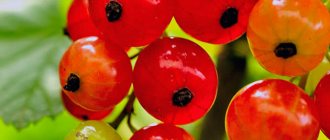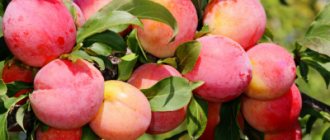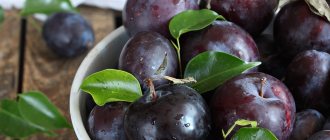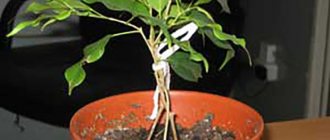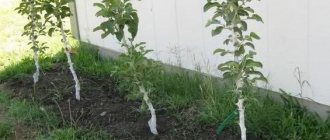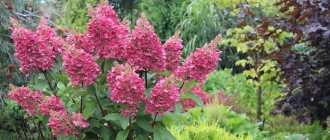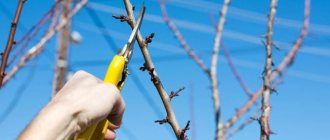Why is pruning done?
As a result of pruning branches, the following effects are obtained:
- increased supply of nutrients to the kidneys and ovary;
- reducing the risk of infection by diseases, fungi and pests;
- formation of a beautiful shape;
- elimination of old and weak shoots;
- constant renewal and extension of the fruiting period of currants.
Proper pruning of currants
To ensure a good harvest, prune old shoots according to certain rules. Black and red berries need to be trimmed differently. In addition, the technique varies depending on the age of the bushes.
Currant pruning occurs according to simple rules:
- A bush of 10-15 branches is formed.
- There should be 2 more annual (light) branches than old ones (with dark bark).
- Prune currants in the spring before the buds open, in the summer after harvest, or in the fall after the leaves fall.
- Spring pruning is carried out for hygiene purposes to get rid of diseased, frozen and old branches.
- Increase the number of buds in the summer by pinching.
Black currants are most often planted. It has a bright taste and grows as a spreading bush with many branches. Therefore, it gives a good decorative effect to the garden plot.
In order for currants to bear fruit well, form several shoots of different ages. There is no point in saving branches that are more than 6 years old: they will draw nutrients onto themselves, and berries will not grow on them. According to the recommendations on how to prune blackcurrants, pruning should be done every year.
One year after landing
As a rule, young bushes have 4 main branches. In the first year, prune the currants to form a beautiful shape and increase the yield. Trim the branches so that 3-4 buds remain. There is no need to leave any more, since all the nutrients will go to them. And later they will give new growth.
A year after planting, trim off all thin and weak branches. You should not feel sorry for them, as they will only take away nutrients. Pruning helps varieties that are not bushy to begin to form side branches.
How to prune currant bushes 2 years after planting
A couple of years after planting, remove young, weak growth. Leave only strong, strong and main shoots.
To enhance bushiness in the middle of the summer, preferably in July, pinch the top pair of buds, or shorten the shoots by 10-15 cm. This will increase the formation of lateral “fruits” and zero shoots directly from the ground.
This procedure gives two effects: increasing productivity and the formation of a beautiful bush shape.
In the fall, cut off weak and underdeveloped branches, as because of them the whole plant will not tolerate winter well and will not receive sufficient nutrition.
3 years later
In the third year of life, young and underdeveloped shoots are pruned, especially in the middle of the bush. They contribute to the thickening and growth of the plant, form a shadow for fruiting branches, which causes aphids and other diseases, and reduces the size of the berries.
Leave 3-6 of the strongest and most developed branches. They also have their tops pinched, leaving only 3-4 buds.
Further pruning of the currant bush
At 5-6 years of life, old branches appear, which are mercilessly disposed of. They will no longer bear fruit. Such shoots are cut off at the very root near the ground. Remove all dry, diseased, aphids and parasites, as well as those that have frozen over the winter.
Cut the rest according to the following pattern:
- Shorten 3-4 year old branches to 2-3 buds.
- For yearlings, cut off only the tops.
- Pinch off shoots that are less than a year old, leaving up to 5 buds.
Do pruning in early spring before buds appear. Pinch out young shoots in mid-summer. And dry branches can be cut off at any time.
What tools are needed
It is almost impossible to carry out such a procedure as pruning currant bushes without improvised means. Therefore, in order to properly form a bush, we stock up on the following equipment:
- wood pruning shears;
- brush cutter;
- garden shears and hacksaw;
- lopper
Before using the gardener's kit, it must be thoroughly sharpened and treated with alcohol. One more point that should also be taken into account. In the case when you are just planning to purchase garden tools, give preference to devices that have thin and long ends.
With the help of such equipment, you will not have any difficulty getting to the most inaccessible place in the currant for proper pruning. And do not forget to cover all the cut areas of the shoots with garden varnish.
Pruning currants in spring
Pruning currants in spring has the following advantages:
- Weak and broken branches will not draw nutrients after winter, when the plant needs to recover and begin to bloom. Strength will be spent on producing new, healthy and fruit-bearing shoots.
- Old ones that did not have berries are eliminated.
- The middle ones are cut off, which can shade and prevent the berries from receiving enough sunlight. As a result of thinning, future berries acquire bright color and taste.
- A bush freed from excess “load” can provide more nutrients to its fruits.
- Spring pruning prevents the development of diseases and the activation of pests under the bark. They can move from diseased and old branches to healthy ones and infect the entire plant.
But it is important to take into account some of the disadvantages of spring pruning:
- They should be carried out within a certain period. Otherwise, the wounds will take too long to heal. The plant will spend a lot of energy on restoration, and not on berries.
- Poor processing of the cut will expose the bush to the risk of pests and diseases.
Carry out pruning in the spring according to the following rules:
- Trim the bush when the weather becomes consistently warm - above +5 degrees, and the danger of repeated frosts has passed. A sign of this is the uniform melting of snow throughout the entire area.
- Do not leave shoots that grow towards the center of the bush.
- Remove young and empty shoots, as they only draw nutrients, but do not bear fruit.
- In order for the bush to grow wider, the last 2 buds on each shoot are cut off.
- The cut is made at an angle of 45 degrees above the bud, pointing outward.
- Do not leave stumps from old branches, as insects and fungi settle in them.
Remember that all manipulations are carried out with clean equipment, treated in a weak solution of potassium permanganate, otherwise you will cause an infection.
To minimize the loss of juice and disinfect against diseases and fungi, treat all cuts with garden varnish. You can purchase it at any gardening or flower shop.
Subsequent care of shrubs
For active growth of root shoots, it is necessary to regularly loosen the soil and keep it free of weeds. When pouring berries, it is important to moisten the soil abundantly, otherwise the berries will be small due to insufficient moisture in the root system.
Each pruning is stress for the plant, and the bush needs feeding for better regeneration of damaged tissues. The need for nutrients depends on the timing of pruning. In spring, fertilizing should include phosphorus and potassium in equal proportions, but the dose of nitrogen should be increased. At this time, you can fertilize the currants with wood ash and organic matter - rotted manure embedded in the soil.
In order to become the owner of an orchard that annually brings a bountiful harvest, it is important to remember the characteristics of each type of plant growing on the site and, in accordance with this, provide them with proper care, focusing on the experience of gardeners and knowledge in the field of agricultural technology.
Is it possible to prune currant branches in summer?
In the summer, carry out sanitary pruning of currants - remove old, dry branches, leaves infected with aphids and powdery mildew. Manipulation should be carried out immediately after picking the berries.
If you doubt whether certain branches can be cut, you can determine their uselessness by the following signs:
- The shoots have a dark brown color with a gray coating (sick branches).
- A small number of growths and buds.
- The leaves have a strange shape and color, a coating, a film, or they are covered with cobwebs from aphids.
- Branches actively growing on the ground, even if there are a lot of berries on them.
- Crooked, long, closely growing shoots.
In summer, remove several old 2-3 year old trunks from red and white currants. In their place, new, young root shoots will grow. Shorten the side branches by 20 cm, and pinch the vertical ones.
Blackcurrant is different in that the berries appear on young shoots that are about 2 years old. Therefore, remove all old, non-fruiting branches.
Only in the summer does it become clear what needs to be removed, which parts are bearing fruit, and which are already drying out and affected by diseases.
Stage one: sanitary
Before pruning the currant bush, you need to clean it:
- cleaning of broken and dry branches is carried out;
- shoots are cut out whose wood has not yet matured (if these shoots are left, they will die in winter under the influence of sub-zero temperatures);
- cut off all deformed shoots;
- remove branches that intertwine with each other or grow towards the central part of the bush;
- destroy diseased branches: shoots that are damaged by infection or pests are burned;
- if one of the branches has grown far from the center or is pressed to the ground, it should also be removed.
Related article:
How to prevent swelling on currant leaves
It is necessary to clean the currant bush: remove broken and dry branches, cut off deformed shoots, destroy diseased branches
How to prune currant bushes in autumn
Pruning currants in the fall is final. As a result of the procedure, an adult bush should have about 15 branches of different ages. Remove all affected areas, dried and young shoots that shade the main fruit-bearing ones. In spring, currants will not waste energy feeding shoots that will not bring benefits. Remove shoots to the very roots so that there is no room for the development of fungi and aphids.
Carry out the procedure in late autumn, when the leaves have fallen, the sap flow has slowed down, but the snow has not yet fallen. However, pruning is possible immediately after harvesting so that the bush has time to get stronger before wintering.
Features of pruning red currants
The structure of red currants is different from black currants. It has many branches that can shade the fruiting ones. Therefore, you need to carefully monitor the currant bush.
The shoots become fruitful only after 5 years of life, and the bush requires rejuvenation after 7 years. Buds with flowers form on young shoots. You should not pinch the ends during the summer months because berries appear at the ends of the shoots.
Unlike black currants, red and white bushes age much later, after 7-8 years of growth. Pruning red currants in the fall involves getting rid of old, diseased, weak, low-lying branches. A healthy adult plant should have about 20 shoots of different years.
For currant lovers, we recommend reading about golden currants.
